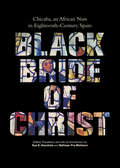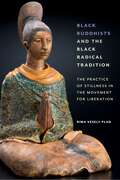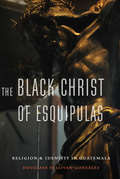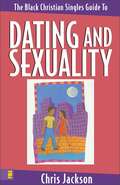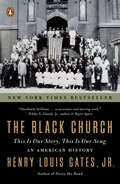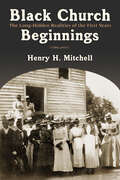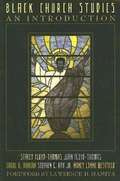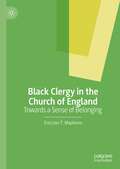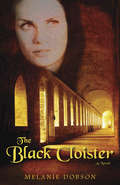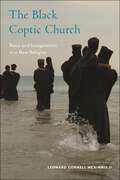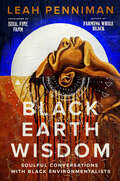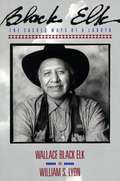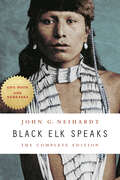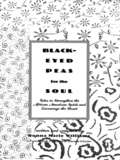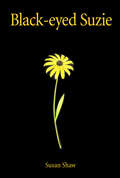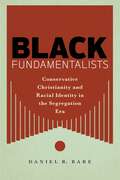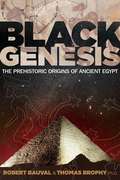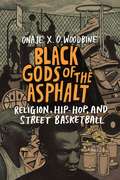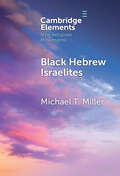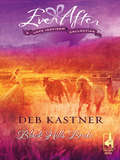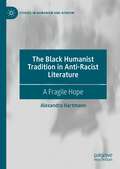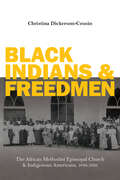- Table View
- List View
Black Bride of Christ: Chicaba, an African Nun in Eighteenth-Century Spain
by Sue E. Houchins and Baltasar Fra-MolineroTeresa de Santo Domingo, born with the name Chicaba, was a slave captured in the territory known to seventeenth- and eighteenth-century Spanish and Portuguese navigators and slave traffickers as La Mina Baja del Oro, the part of West Africa that extends through present-day eastern Ghana, Togo, Benin, and western Nigeria. Upon the death of her Spanish master, Chicaba was freed to enter a convent. The Dominicans of La Penitencia in Salamanca accepted her after she had been rejected by several other monasteries because of her skin color. Even in her own religious community, race put her at a disadvantage in the highly stratified social hierarchy of monastic houses of the era. Her life story is known to us through a document entitled Compendio de la vida ejemplar de la Venerable Madre Sor Teresa Juliana de Santo Domingo, which is the foundational documentary evidence in the case for beatification of this nun, and as such it is the most significant and comprehensive source of information about her. This volume, the first English translation of the Compendio, is a hagiography, an example of a biographical genre that recounts the lives and describes the spiritual practices of saints officially canonized by the Church, respected ecclesiastical leaders, or holy people informally recognized by local devotees. The effort to have Chicaba canonized continues today, as Fra-Molinero and Houchins explore in their introduction to the volume.
Black British Gospel Music: From the Windrush Generation to Black Lives Matter (Congregational Music Studies Series)
by Monique M. Ingalls Dulcie Dixon McKenzie Pauline MuirBlack British Gospel Music is a dynamic and multifaceted musical practice, a diasporic river rooted in the experiences of Black British Christian communities. This book examines gospel music in Britain in both historical and contemporary perspectives, demonstrating the importance of this this vital genre to scholars across disciplines. Drawing on a plurality of voices, the book examines the diverse streams that contribute to and flow out of this significant genre. Gospel can be heard resonating within a diverse array of Christian worship spaces; as a form of community music-making in school halls; and as a foundation for ‘secular’ British popular music, including R&B, hip hop and grime.
Black Buddhists and the Black Radical Tradition: The Practice of Stillness in the Movement for Liberation
by Rima Vesely-FladFinalist, Award for Excellence in the Study of Religion, Constructive-Reflective Studies, given by the American Academy of ReligionExplores how Black Buddhist Teachers and Practitioners interpret Western Buddhism in unique spiritual and communal ways In Black Buddhists and the Black Radical Tradition, Rima Vesely-Flad examines the distinctive features of Black-identifying Buddhist practitioners, arguing that Black Buddhists interpret Buddhist teachings in ways that are congruent with Black radical thought. Indeed, the volume makes the case that given their experiences with racism—both in the larger society and also within largely white-oriented Buddhist organizations—Black cultural frameworks are necessary for illuminating the Buddha’s wisdom. Drawing on interviews with forty Black Buddhist teachers and practitioners, Vesely-Flad argues that Buddhist teachings, through their focus on healing intergenerational trauma, provide a vitally important foundation for achieving Black liberation. She shows that Buddhist teachings as practiced by Black Americans emphasize different aspects of the religion than do those in white convert Buddhist communities, focusing more on devotional practices to ancestors and community uplift.The book includes discussions of the Black Power movement, the Black feminist movement, and the Black prophetic tradition. It also offers a nuanced discussion of how the Black body, which has historically been reviled, is claimed as a vehicle for liberation. In so doing, the book explores how the experiences of non-binary, gender non-conforming, and transgender practitioners of African descent are validated within the tradition. The book also uplifts the voices of lesbian, gay, bisexual, and queer Black Buddhists. This unique volume shows the importance of Black Buddhist teachers’ insights into Buddhist wisdom, and how they align Buddhism with Black radical teachings, helping to pull Buddhism away from dominant white cultural norms.
The Black Christ of Esquipulas: Religion and Identity in Guatemala
by Douglass Sullivan-GonzalezOn the eastern border of Guatemala and Honduras, pilgrims and travelers flock to the Black Christ of Esquipulas, a large statue carved from wood depicting Christ on the cross. The Catholic shrine, built in the late sixteenth century, has become the focal point of admiration and adoration from New Mexico to Panama. Beyond being a site of popular devotion, however, the Black Christ of Esquipulas was also the scene of important debates about citizenship and identity in the Guatemalan nation throughout the nineteenth and twentieth centuries. In The Black Christ of Esquipulas, Douglass Sullivan-González explores the multifaceted appeal of this famous shrine, its mysterious changes in color over the centuries, and its deeper significance in the spiritual and political lives of Guatemalans. Reconstructed from letters buried within the restricted Catholic Church archive in Guatemala City, the debates surrounding the shrine reflect the shifting categories of race and ethnicity throughout the course of the country’s political trajectory. This “biography” of the Black Christ of Esquipulas serves as an alternative history of Guatemala and sheds light on some of the most salient themes in Guatemala’s social and political history: state formation, interethnic dynamics, and church-state tensions. Sullivan-González’s study provides a holistic understanding of the relevance of faith and ritual to the social and political history of this influential region.
The Black Christian Singles Guide To Dating and Sexuality
by Chris Jackson“More than a book, it’s a ministry in print . . . touching areas that the church has long covered up or overlooked.” (Jerry Adkisson, Singles Ministry President, The Temple Church, Nashville, Tennessee)Between the onset of puberty and marriage, every man and woman faces the issues of being single. How do you handle the weekends alone—or with a dating partner? How do you build a healthy relationship? How can you tell when it’s the relationship of a lifetime? Anwhat about sex—Why say no when your body is screaming yes? Chris Jackson knows the promise and the pitfalls of singleness for African Americans. In this book, he offers frank, down-to-earth wisdom on such topics as practical ways to make the single life a better life; making the most of The differences between the sexes; how your family history affects your dating relationship. Jackson also covers the silent issues: masturbation, date rape, and homosexuality; Breaking up without breaking down; knowing when a relationship is marriageable . . . And much more If you want to order your dating life according to the Bible’s prescription for fulfillment, The Black Christian Singles Guide to Dating and Sexuality is an invaluable guidebook. It’s easy to read, and it offers real-life answers for your real-life issues.“Dr. Chris Jackson gives us a fresh and creative approach to the standards, hopes, and possibilities for Christians who are single. He challenges singles to seek wholeness and fulfillment in Christ. It is a very good book.” —Dr. John H. Corbitt, National Dean, National Baptist Congress of Christian Education, Greenville, South Carolina
The Black Church: This Is Our Story, This Is Our Song
by Henry Louis GatesFrom the New York Times bestselling author of Stony the Road and one of our most important voices on the African American experience comes a powerful new history of the Black church as a foundation of Black life and a driving force in the larger freedom struggle in America. <P><P>The companion book to the upcoming PBS series. <P><P>For the young Henry Louis Gates, Jr., growing up in a small, residentially segregated West Virginia town, the church was a center of gravity—an intimate place where voices rose up in song and neighbors gathered to celebrate life's blessings and offer comfort amid its trials and tribulations. In this tender and expansive reckoning with the meaning of the Black Church in America, Gates takes us on a journey spanning more than five centuries, from the intersection of Christianity and the transatlantic slave trade to today’s political landscape. At road’s end, and after Gates’s distinctive meditation on the churches of his childhood, we emerge with a new understanding of the importance of African American religion to the larger national narrative—as a center of resistance to slavery and white supremacy, as a magnet for political mobilization, as an incubator of musical and oratorical talent that would transform the culture, and as a crucible for working through the Black community’s most critical personal and social issues. <P><P>In a country that has historically afforded its citizens from the African diaspora tragically few safe spaces, the Black Church has always been more than a sanctuary. This fact was never lost on white supremacists: from the earliest days of slavery, when enslaved people were allowed to worship at all, their meetinghouses were subject to surveillance and destruction. Long after slavery’s formal eradication, church burnings and bombings by anti-Black racists continued, a hallmark of the violent effort to suppress the African American struggle for equality. The past often isn’t even past—Dylann Roof committed his slaughter in the Mother Emanuel AME Church 193 years after it was first burned down by white citizens of Charleston, South Carolina, following a thwarted slave rebellion. <P><P>But as Gates brilliantly shows, the Black church has never been only one thing. Its story lies at the heart of the Black political struggle, and it has produced many of the Black community's most notable leaders. At the same time, some churches and denominations have eschewed political engagement and exemplified practices of exclusion and intolerance that have caused polarization and pain. Those tensions remain today, as a rising generation demands freedom and dignity for all within and beyond their communities, regardless of race, sex, or gender. Still, as a source of faith and refuge, spiritual sustenance and struggle against society’s darkest forces, the Black Church has been central, as this enthralling history makes vividly clear. <p><p><b>A New York Times Bestseller</b>
Black Church Beginnings: The Long-Hidden Realities of the First Years
by Henry H. MitchellBlack Church Beginnings provides an intimate look at the struggles of African Americans to establish spiritual communities in the harsh world of slavery in the American colonies. Written by one of today's foremost experts on African American religion, this book traces the growth of the black church from its start in the mid-1700s to the end of the nineteenth century.As Henry Mitchell shows, the first African American churches didn't just organize; they labored hard, long, and sacrificially to form a meaningful, independent faith. Mitchell insightfully takes readers inside this process of development. He candidly examines the challenge of finding adequately trained pastors for new local congregations, confrontations resulting from internal class structure in big city churches, and obstacles posed by emerging denominationalism.Original in its subject matter and singular in its analysis, Mitchell's Black Church Beginnings makes a major contribution to the study of American church history.
Black Church Studies: An Introduction
by Carol B. Duncan Nancy Lynne Westfield Stephen G. Ray Stacey Floyd-Thomas Juan M. Floyd-ThomasReligious StudiesOver the last thirty years African American voices and perspectives have become essential to the study of the various theological disciplines. Writing out of their particular position in the North American context, African American thinkers have contributed significantly to biblical studies, theology, church history, ethics, sociology of religion, homiletics, pastoral care, and a number of other fields. Frequently the work of these African American scholars is brought together in the seminary curriculum under the rubric of the black church studies class. Drawing on these several disciplines, the black church studies class seeks to give an account of the broad meaning of Christian faith in the African American experience. Up to now, however, there has not been a single, comprehensive textbook designed to meet the needs of students and instructors in these classes. Black Church Studies: An Introduction will meet that need. Drawing on the work of specialists in several fields, it introduces all of the core theological disciplines from an African American standpoint, from African American biblical interpretation to womanist theology and and ethics to sociological understandings of the life of African American churches. It will become an indispensable resource for all those preparing to serve in African American congregations, or to understand African American contributions to the study of Christian faith. Looks at the diverse definitions and functions of the Black Church as well as the ways in which race, class, religion, and gender inform its evolution. Provides a comprehensive view of the contributions of African American Scholarship to the current theological discussion. Written by scholars with broad expertise in a number of subject areas and disciplines. Will enable the reader to relate the work of African American theological scholars to the tasks of preaching, teaching, and leading in local congregations. Will provide the reader the most comprehensive understanding of African American theological scholarship available in one volume. Stacey Floyd-Thomas, Brite Divinity SchoolJuan Floyd-Thomas, Texas Christian UniversityCarol B. Duncan, Wilfrid Laurier UniversityStephen G. Ray Jr., Lutheran Theological Seminary-PhiladelphiaNancy Lynne Westfield, Drew UniversityTheology/Theology and Doctrine/Contemporary Theology
Black Clergy in the Church of England: Towards a Sense of Belonging
by Ericcson T. MapfumoThis book explores the experiences of ordinands and Black clergy of the Church of England (CofE). An increasing number of Black ordinands (trainees) from African and Caribbean heritages are choosing a ministerial pathway in the Anglican Communion, which has necessitated insights which recognise what they have to bring from their place of origin. Accounts of some of their relationships in the Church of England have been documented and reports on the issues and challenges of institutionalised racism. Anecdotal reference also suggests that the CofE has become a White institution which has not supported its Black clergy in their ministry. The purpose of this book is to present the lived experience of Black clergy in the Church of England, while highlighting some of the challenges they face and to offer solutions to make the church anti-racist.
The Black Cloister: A Novel
by Melanie DobsonOn Elise Friedman's eighth birthday, she lost her mother and any connection to her mysterious past. Raised by her loving stepfather, Elise has spent years trying to learn the truth about her mother, Catrina, and her birth family in Germany, but still knows very little. Now a young woman in college, Elise is traveling to her homeland of Germany to uncover her family's past, but what she finds is much more harrowing than she ever suspected.
The Black Coptic Church: Race and Imagination in a New Religion (Religion, Race, and Ethnicity)
by Leonard Cornell McKinnis IIProvides an illuminating look at the diverse world of Black religious life in North America, focusing particularly outside of mainstream Christian churchesFrom the Moorish Science Temple to the Peace Mission Movement of Father Divine to the Commandment Keepers sect of Black Judaism, myriad Black new religious movements developed during the time of the Great Migration. Many of these stood outside of Christianity, but some remained at least partially within the Christian fold. The Black Coptic Church is one of these. Black Coptics combined elements of Black Protestant and Black Hebrew traditions with Ethiopianism as a way of constructing a divine racial identity that embraced the idea of a royal Egyptian heritage for its African American followers, a heroic identity that was in stark contrast to the racial identity imposed on African Americans by the white dominant culture. This embrace of a royal Blackness—what McKinnis calls an act of “fugitive spirituality”—illuminates how the Black Coptic tradition in Chicago and beyond uniquely employs a religio-performative imagination. McKinnis asks, ‘What does it mean to imagine Blackness?’ Drawing on ten years of archival research and interviews with current members of the church, The Black Coptic Church offers a look at a group that insisted on its own understanding of its divine Blackness. In the process, it provides a more complex look at the diverse world of Black religious life in North America, particularly within non-mainstream Christian churches.
Black Earth Wisdom: Soulful Conversations with Black Environmentalists
by Leah PennimanA soulful collection of illuminating essays and interviews that explore Black people’s spiritual and scientific connection to the land, waters, and climate, curated by the acclaimed author of Farming While BlackAuthor of Farming While Black and co-founder of Soul Fire Farm, Leah Penniman reminds us that ecological humility is an intrinsic part of Black cultural heritage. While racial capitalism has attempted to sever our connection to the sacred earth for 400 years, Black people have long seen the land and water as family and understood the intrinsic value of nature.This thought-provoking anthology brings together today’s most respected and influential Black environmentalist voices —leaders who have cultivated the skill of listening to the Earth —to share the lessons they have learned. These varied and distinguished experts include Pulitzer Prize and National Book Award-winning author Alice Walker; the first Queen Mother and official spokesperson for the Gullah/Geechee Nation, Queen Quet; marine biologist, policy expert, and founder and president of Ocean Collectiv, Dr. Ayana Elizabeth Johnson; and the Executive Director of the North Carolina Association of Black Lawyers, Land Loss Prevention Project, Savi Horne. In Black Earth Wisdom, they address the essential connection between nature and our survival and how runaway consumption and corporate insatiability are harming the earth and every facet of American society, engendering racial violence, food apartheid, and climate injustice.Those whose skin is the color of soil are reviving their ancestral and ancient practice of listening to the earth for guidance. Penniman makes clear that the fight for racial and environmental justice demands that people put our planet first and defer to nature as our ultimate teacher.Contributors include:Alice Walker • adrienne maree brown • Dr. Ross Gay • Dr. Ayana Elizabeth Johnson • Rue Mapp • Dr. Carolyn Finney • Audrey Peterman • Awise Agbaye Wande Abimbola • Ibrahim Abdul-Matin • Kendra Pierre-Louis • Latria Graham • Dr. Lauret Savoy •Ira Wallace • Savi Horne • Dr. Claudia Ford • Dr. J. Drew Lanham • Dr. Leni Sorensen • Queen Quet • Toshi Reagon • Yeye Luisah Teish • Yonnette Fleming • Naima Penniman • Angelou Ezeilo • James Edward Mills • Teresa Baker • Pandora Thomas • Toi Scott • Aleya Fraser • Chris Bolden-Newsome • Dr. Joshua Bennett • B. Anderson • Chris Hill • Greg Watson • T. Morgan Dixon • Dr. Dorceta Taylor • Colette Pichon Battle • Dillon Bernard • Sharon Lavigne • Steve Curwood • and Babalawo Enroue Halfkenny
Black Elk: The Sacred Ways of a Lakota
by Wallace H. Black Elk William S. LyonBlack Elk writes about religion and mythology in the Lakota Nation and North American shamanism.
Black Elk Speaks: The Complete Edition (Native American Wisdom Ser.)
by John G. Neihardt Philip J. Deloria Vine Deloria Jr.Black Elk Speaks, the story of the Oglala Lakota visionary and healer Nicholas Black Elk (1863–1950) and his people during momentous twilight years of the nineteenth century, offers readers much more than a precious glimpse of a vanished time. Black Elk’s searing visions of the unity of humanity and Earth, conveyed by John G. Neihardt, have made this book a classic that crosses multiple genres. Whether appreciated as the poignant tale of a Lakota life, as a history of a Native nation, or as an enduring spiritual testament, Black Elk Speaks is unforgettable. Black Elk met the distinguished poet, writer, and critic John G. Neihardt in 1930 on the Pine Ridge Reservation in South Dakota and asked Neihardt to share his story with the world. Neihardt understood and conveyed Black Elk’s experiences in this powerful and inspirational message for all humankind. This complete edition features a new introduction by historian Philip J. Deloria and annotations of Black Elk’s story by renowned Lakota scholar Raymond J. DeMallie. Three essays by John G. Neihardt provide background on this landmark work along with pieces by Vine Deloria Jr., Raymond J. DeMallie, Alexis Petri, and Lori Utecht. Maps, original illustrations by Standing Bear, and a set of appendixes rounds out the edition.
Black Eyed Peas for the Soul
by Donna Marie WilliamsTo tell a story well, you have to live a story well -- with courage, persistence, and faith that everything's going to turn out all right. Black-Eyed Peas for the Soul is a collection of stories that reveals universal themes, as well as the unique perspectives of African Americans. The first collection of its kind, Black-Eyed Peas for the Soul boldly dispels the myth of a homogeneous Black culture. Diverse voices -- including those of Zora Neale Hurston, Dawn Turner Trice, and Frederick Douglass -- tell our stories of beginnings, wisdom, patience, hard work, excellence, joy, and miracles. Stories about love, healing, and atonement are told with insight, humor, and gritty honesty. Arising from these distinct voices is the call for hope. Enjoy these stories and let them guide your soul to a place where you can find solace and draw nourishment, a place that can warm and soothe you, like a bowl of black-eyed peas.
Black-eyed Suzie
by Susan ShawSuzie is a dark-eyed twelve-year-old who desperately needs to feel safe and worthy of love. Seeking only to be "good enough," she remains motionless and silent for hours on end, feeling the walls of her psychological prison pressing against her. Ultimately, Suzie finds herself in a mental hospital where she begins a long and fear-filled journey. To make sense of her world, Suzie must piece together a puzzle that involves seemingly unrelated clues--a broken bicycle, a torn picture, peacock feathers, and more--which together reveal a secret that is likely to change Suzie's life forever, and give her an opportunity to regain her voice and reclaim here spirit.
Black Fundamentalists: Conservative Christianity and Racial Identity in the Segregation Era
by Daniel R Bare&“Trac[es] the history of black fundamentalism [and] makes several noteworthy observations about Christianity and race in America . . . [a] fine work.&” ―Southeastern Theological Review As the modernist-fundamentalist controversy came to a head in the early twentieth century, an image of the &“fighting fundamentalist&” was imprinted on the American cultural consciousness. To this day, the word &“fundamentalist&” often conjures the image of a fire-breathing preacher—strident, unyielding in conviction . . . and almost always white. But did this major religious perspective really stop cold in its tracks at the color line?Black Fundamentalists challenges the idea that fundamentalism was an exclusively white phenomenon. The volume uncovers voices from the Black community that embraced the doctrinal tenets of the movement and, in many cases, explicitly self-identified as fundamentalists. Fundamentalists of the early twentieth century felt the pressing need to defend the &“fundamental&” doctrines of their conservative Christian faith—doctrines like biblical inerrancy, the divinity of Christ, and the virgin birth—against what they saw as the predations of modernists who represented a threat to true Christianity. Such concerns, attitudes, and arguments emerged among Black Christians as well as white, even as the oppressive hand of Jim Crow excluded African Americans from the most prominent white-controlled fundamentalist institutions and social crusades, rendering them largely invisible to scholars examining such movements. Black fundamentalists aligned closely with their white counterparts on the theological particulars of &“the fundamentals.&” Yet they often applied their conservative theology in more progressive, racially contextualized ways. While white fundamentalists were focused on battling the teaching of evolution, Black fundamentalists were tying their conservative faith to advocacy for reforms in public education, voting rights, and the overturning of legal bans on intermarriage. Beyond the narrow confines of the fundamentalist movement, Daniel R. Bare shows how these historical dynamics illuminate larger themes, still applicable today, about how racial context influences religious expression. &“One of the first significant historical studies on Black religious conservatives during the interwar period.&” ―Journal of the American Academy of Religion
Black Genesis: The Prehistoric Origins of Ancient Egypt
by Robert Bauval Thomas BrophyPresents proof that an advanced black African civilization inhabited the Sahara long before Pharaonic Egypt • Reveals black Africa to be at the genesis of ancient civilization and the human story • Examines extensive studies into the lost civilization of the “Star People” by renowned anthropologists, archaeologists, genetic scientists, and cultural historians as well as the authors’ archaeoastronomy and hieroglyphics research • Deciphers the history behind the mysterious Nabta Playa ceremonial area and its stone calendar circle and megaliths Relegated to the realm of archaeological heresy, despite a wealth of hard scientific evidence, the theory that an advanced civilization of black Africans settled in the Sahara long before Pharaonic Egypt existed has been dismissed and even condemned by conventional Egyptologists, archaeologists, and the Egyptian government. Uncovering compelling new evidence, Egyptologist Robert Bauval and astrophysicist Thomas Brophy present the anthropological, climatological, archaeological, geological, and genetic research supporting this hugely debated theory of the black African origin of Egyptian civilization. Building upon extensive studies from the past four decades and their own archaeoastronomical and hieroglyphic research, the authors show how the early black culture known as the Cattle People not only domesticated cattle but also had a sophisticated grasp of astronomy; created plentiful rock art at Gilf Kebir and Gebel Uwainat; had trade routes to the Mediterranean coast, central Africa, and the Sinai; held spiritual and occult ceremonies; and constructed a stone calendar circle and megaliths at the ceremonial site of Nabta Playa reminiscent of Stonehenge, yet much older. Revealing these “Star People” as the true founders of ancient Egyptian civilization, this book completely rewrites the history of world civilization, placing black Africa back in its rightful place at the center of mankind’s origins.
Black Gods of the Asphalt: Religion, Hip-Hop, and Street Basketball
by Onaje X. WoodbineJ-Rod moves like a small tank on the court, his face mean, staring down his opponents. "I play just like my father," he says. "Before my father died, he was a problem on the court. I'm a problem." Playing basketball for him fuses past and present, conjuring his father's memory into a force that opponents can feel in each bone-snapping drive to the basket. On the street, every ballplayer has a story. Onaje X. O. Woodbine, a former streetball player who became an all-star Ivy Leaguer, brings the sights and sounds, hopes and dreams of street basketball to life. He shows that big games have a trickster figure and a master of black talk whose commentary interprets the game for audiences. The beats of hip-hop and reggae make up the soundtrack, and the ballplayers are half-men, half-heroes, defying the ghetto's limitations with their flights to the basket.Basketball is popular among young black American men but not because, as many claim, they are "pushed by poverty" or "pulled" by white institutions to play it. Black men choose to participate in basketball because of the transcendent experience of the game. Through interviews with and observations of urban basketball players, Onaje X. O. Woodbine composes a rare portrait of a passionate, committed, and resilient group of athletes who use the court to mine what urban life cannot corrupt. If people turn to religion to reimagine their place in the world, then black streetball players are indeed the hierophants of the asphalt.
Black Gods of the Metropolis
by Barbara Dianne Savage John Szwed Arthur Huff FausetStemming from his anthropological field work among black religious groups in Philadelphia in the early 1940s, Arthur Huff Fauset believed it was possible to determine the likely direction that mainstream black religious leadership would take in the future, a direction that later indeed manifested itself in the civil rights movement. The American black church, according to Fauset and other contemporary researchers, provided the one place where blacks could experiment without hindrance in activities such as business, politics, social reform, and social expression. With detailed primary accounts of these early spiritual movements and their beliefs and practices, Black Gods of the Metropolis reveals the fascinating origins of such significant modern African American religious groups as the Nation of Islam as well as the role of lesser known and even forgotten churches in the history of the black community.In her new foreword, historian Barbara Dianne Savage discusses the relationship between black intellectuals and black religion, in particular the relationship between black social scientists and black religious practices during Fauset's time. She then explores the complexities of that relationship and its impact on the intellectual and political history of African American religion in general.
Black Hebrew Israelites (Elements in New Religious Movements)
by Michael T. MillerThe Black Hebrew Israelite movement claims that African Americans are descendants of the Ancient Israelites and has slowly become a significant force in African American religion. This Element provides a general overview of the BHI movement, its diverse history/ies, ideologies, and practices. The Element shows how different factions and trends have taken the forefront at different periods over its 140-year history, leading to the current situation where diverse iterations of the movement exist alongside each other, sharing some core concepts while differing widely. In particular, the questions of how and why BHI has become a potent and attractive movement in recent years are addressed, arguing that it fulfils a specific religious need to do with identity and teleology, and represents a new and persistent form of Abrahamic religion.
Black Hills Bride (Steeple Hill Love Inspired Ser. #No. 90)
by Deb KastnerThough Dixie Sullivan knew it was God's plan that she come to the beautiful South Dakota woodlands to open a retreat lodge, she'd never felt more alone or underqualified. Until God provided help in the form of a stray Border collie and a handsome cowboy. But Erik Wheeler was anything but an angel as he stormed into Dixie's orderly life with the force of a tornado. Dixie could see skepticism in her new foreman's eyes, yet she soon proved that with faith and determination, miracles could happen. And as Erik turned her dreams into a reality, she wished for an even bigger miracle-one that would make her Erik's Black Hills Bride!
Black Holes in the Dead Sea Scrolls
by Robert FeatherAn utterly compelling biblical detective story that exposes the truth behind the delays in the translation and publication of the Dead Sea Scrolls.
The Black Humanist Tradition in Anti-Racist Literature: A Fragile Hope (Studies in Humanism and Atheism)
by Alexandra HartmannThis book presents an intellectual history and theoretical exploration of black humanism since the civil rights era. Humanism is a human-centered approach to life that considers human beings to be responsible for the world and its course of history. Both the heavily theistic climate in the United States as well as the dominance of the Black Church are responsible for black humanism’s existence in virtual oblivion. For those who believe the world to be one without supernatural interventions, human action matters greatly and is the only possible mode for change. Humanists are thus committed to promoting the public good through human effort rather than through faith. Black humanism originates from the lived experiences of African Americans in a white hegemonic society. Viewed from this perspective, black humanist cultural expressions are a continuous push to imagine and make room for alternative life options in a racist society. Alexandra Hartmann counters religion’s hegemonic grasp and uncovers black humanism as a small yet significant tradition in recent African American culture and cultural politics by studying its impact on African American literature and the ensuing anti-racist potentials. The book demonstrates that black humanism regards subjectivity as embodied and is thus a worldview that is characterized by a fragile hope regarding the possibility of progress – racial and otherwise – in the country.
Black Indians and Freedmen: The African Methodist Episcopal Church and Indigenous Americans, 1816-1916
by Christina Dickerson-CousinOften seen as ethnically monolithic, the African Methodist Episcopal (AME) Church in fact successfully pursued evangelism among diverse communities of indigenous peoples and Black Indians. Christina Dickerson-Cousin tells the little-known story of the AME Church’s work in Indian Territory, where African Methodists engaged with people from the Five Civilized Tribes (Cherokees, Creeks, Choctaws, Chickasaws, and Seminoles) and Black Indians from various ethnic backgrounds. These converts proved receptive to the historically Black church due to its traditions of self-government and resistance to white hegemony, and its strong support of their interests. The ministers, guided by the vision of a racially and ethnically inclusive Methodist institution, believed their denomination the best option for the marginalized people. Dickerson-Cousin also argues that the religious opportunities opened up by the AME Church throughout the West provided another impetus for Black migration. Insightful and richly detailed, Black Indians and Freedmen illuminates how faith and empathy encouraged the unique interactions between two peoples.
